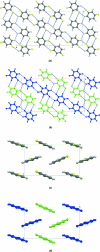1,3-Difluoro-benzene
- PMID: 21578278
- PMCID: PMC2971077
- DOI: 10.1107/S1600536809038987
1,3-Difluoro-benzene
Abstract
The weak electrostatic and dispersive forces between C(δ+)-F(δ-) and H(δ+)-C(δ-) are at the borderline of the hydrogen-bond phenomenon and are poorly directional and further deformed in the presence of other dominant inter-actions, e.g. C-H⋯π. The title compound, C(6)H(4)F(2), Z' = 2, forms one-dimensional tapes along two homodromic C-H⋯F hydrogen bonds. The one-dimensional tapes are connected into corrugated two-dimensional sheets by further bi- or trifrucated C-H⋯F hydrogen bonds. Packing in the third dimension is controlled by C-H⋯π inter-actions.
Figures


References
-
- Althoff, G., Ruiz, J., Rodriguez, V., Lopez, G., Perez, J. & Janiak, C. (2006). CrystEngComm, 8, 662–665.
-
- Bats, J. W., Parsch, J. & Engels, J. W. (2000). Acta Cryst. C56, 201–205. - PubMed
-
- Boese, R. & Nussbaumer, M. (1994). In Situ Crystallisation Techniques. In Organic Crystal Chemistry, edited by D. W. Jones, pp. 20–37. Oxford University Press.
-
- Bruker (2004). SADABS Bruker AXS Inc., Madison, Wisconsin, USA.
-
- Bruker (2008). APEX2 and SAINT Bruker AXS Inc., Madison, Wisconsin, USA.
LinkOut - more resources
Full Text Sources
Research Materials
Miscellaneous
